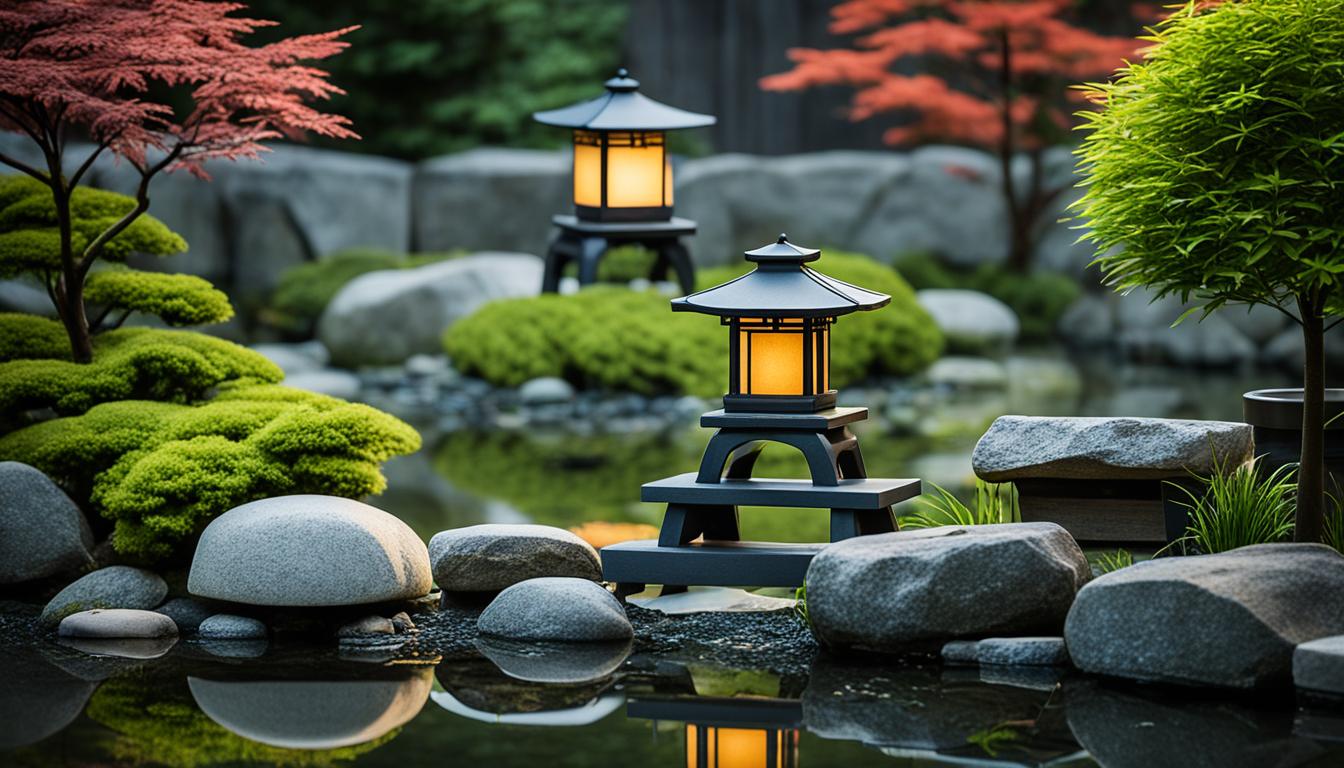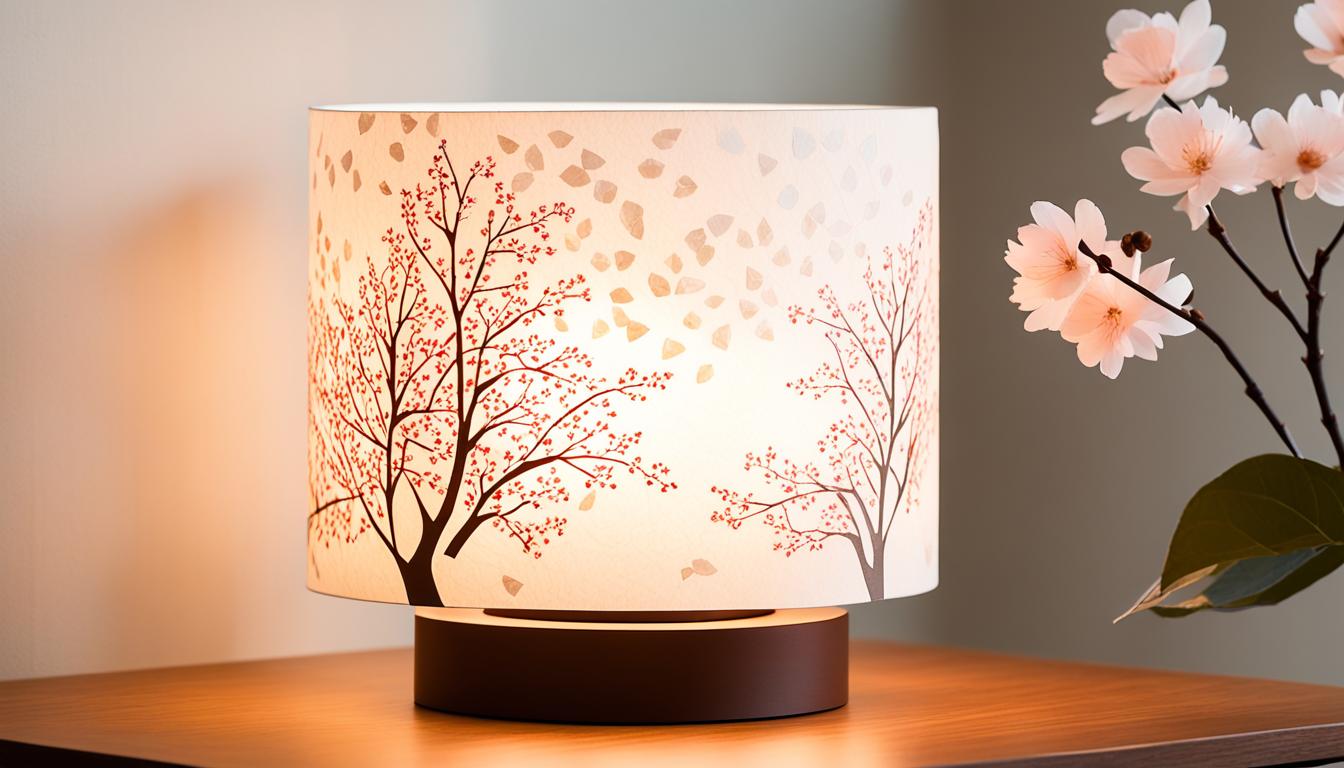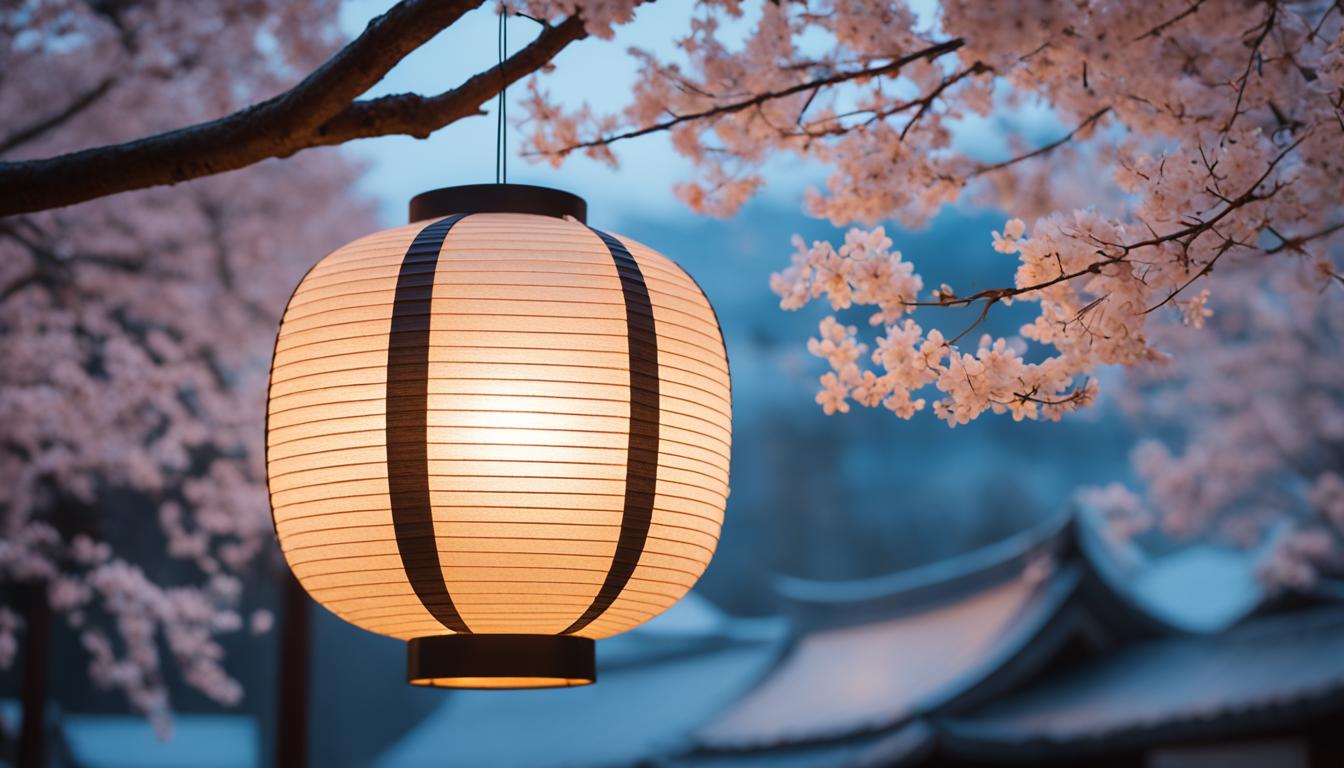✅ FREE SHIPPING in the USA ✅ 30-DAY MONEY BACK GUARANTEE
✅ FREE SHIPPING in the USA ✅ 30-DAY MONEY BACK GUARANTEE
Welcome to our article, where we dive into the fascinating world of Japanese lamps.
These traditional lighting fixtures have a rich cultural history and hold significant meaning in Japanese aesthetics and traditions.
From Japanese lanterns to paper lamps, we will explore the various types of Japanese lamps and uncover the unique names they are known by today.

Japanese lamps hold a deep cultural significance and are an integral part of Japanese traditions.
These lamps are not merely functional lighting fixtures; they are imbued with symbolism and meaning that reflect the values and aesthetics of Japanese culture.
One significant influence on the design and style of Japanese lamps is the concept of Wabi Sabi.
Wabi Sabi is a Japanese aesthetic that celebrates the beauty of imperfection, simplicity, and the transient nature of all things.
This philosophy emphasizes finding beauty in the natural and imperfect, which is reflected in the design of Japanese lamps.
Moreover, Japanese lamps are also influenced by the tea ceremony culture, which places great importance on hospitality and mindfulness.
The tea ceremony is a traditional Japanese ritual that embodies harmony, respect, and tranquility.
Japanese lamps, with their warm and inviting glow, evoke a sense of hospitality and create a peaceful atmosphere.
Japanese lanterns, in particular, are considered symbols of hospitality.
In Japanese culture, lanterns are often used to guide guests and provide a warm welcome.
The soft and subdued light emitted by these lanterns creates an inviting ambiance, making guests feel comfortable and at ease.
The cultural significance of Japanese lamps lies in their ability to embody Wabi Sabi principles, evoke the spirit of the tea ceremony, and symbolize hospitality.
These lamps serve as a reminder to appreciate the beauty in simplicity, embrace mindfulness, and extend warmth and hospitality to others.
In this section, we will focus on two specific types of Japanese lamps: Toro and Ishidoro.
These lamps have distinct names that reflect their cultural significance and design.

Toro refers to traditional Japanese stone lanterns that are often found in temples, shrines, and gardens.
These lanterns are made of stone and are typically characterized by a tall central column, multiple levels, and a roof-like top.
Toro lamps serve both practical and symbolic purposes, providing illumination and serving as a marker for sacred spaces.
Ishidoro, on the other hand, refers to stone lanterns that are buried in the ground.
These lanterns are also made of stone and consist of a partially buried base with a central column and a roof-like top.
Both Toro and Ishidoro lamps are iconic symbols of Japanese aesthetics and are widely recognized for their timeless beauty and cultural significance.
Let's dive deeper into the characteristics and uses of these traditional Japanese lighting fixtures.
Japanese lamps have a long and fascinating history that can be traced back to their origins in China.
The evolution of Japanese lamps is a testament to the cultural exchanges and influences that have shaped their design and functionality over time.
In this section, we will explore the journey of Japanese lighting fixtures from China to Japan and how they were integrated into Japanese temples and shrines.
The history of Japanese lighting fixtures begins with their introduction from China during the Asuka period (538-710 AD).
Chinese influence played a crucial role in shaping the early designs of Japanese lamps.
The Chinese tradition of using lanterns for religious and decorative purposes was adopted and modified by Japanese craftsmen, incorporating their own unique artistic sensibilities.
As time went on, the design and construction of Japanese lamps began to evolve, reflecting the distinct aesthetics and cultural preferences of the Japanese people.
The use of different materials such as wood, iron, and stone further contributed to the diversity of Japanese lamp styles.
One of the key places where Japanese lamps found significant integration was in temples and shrines.
Japanese Buddhism, which was heavily influenced by Chinese Buddhism, embraced the use of lamps for both practical and symbolic purposes.
The soft glow of the lamps added to the atmosphere of tranquility and reverence.
Japanese temples and shrines became showcases for the exquisite craftsmanship of Japanese lamps.
Stone lanterns, known as "Toro," were particularly favored in these sacred spaces.
Their elegant and sturdy design symbolized the eternal nature of Buddhism and created a peaceful ambiance for visitors.
Despite their traditional roots, Japanese lamps have seamlessly integrated into modern interior design.
With their timeless appeal and elegant craftsmanship, these lamps add a touch of sophistication to contemporary spaces.
In this section, we will explore how ancient lamp designs have been adapted to suit the aesthetics of modern interiors.
The beauty of traditional Japanese lamps lies in their ability to effortlessly blend with modern design sensibilities.
By incorporating these lamps into contemporary spaces, interior designers have successfully created visually stunning environments that pay homage to Japan's rich cultural heritage.
The minimalistic lines and subtle elegance of traditional lamp designs complement the clean, minimalist aesthetics of modern interiors, resulting in a harmonious fusion of old and new.
One of the key techniques used in adapting ancient lamp designs for modern spaces is the careful selection of materials.
While traditional lamps were predominantly crafted from wood and stone, modern versions often feature materials such as metal, glass, and even plastic.
This adaptation allows for greater flexibility in terms of design, durability, and affordability, making traditional Japanese lamps accessible to a wider audience.
One particularly striking adaptation of traditional Japanese lamps is the use of Japanese paper, known as Washi, in their construction.
Japanese paper lamps, also known as paper lanterns, have become iconic symbols of Japanese design and artistry.
The delicate and translucent quality of Washi paper allows for a soft, diffused glow that gently illuminates the surrounding space.
These paper lamps create an inviting and warm ambiance, adding a sense of tranquility to any room.
The use of Washi paper in modern interiors adds a layer of authenticity and nostalgia while incorporating modern technological advancements in lighting.

Inspired by traditional Japanese lanterns, contemporary paper lamps feature innovative designs that cater to a variety of interior styles.
From sleek and minimalist to ornate and decorative, these lamps offer a versatile lighting solution that effortlessly complements any modern space.
Whether used as statement pieces in living rooms, as pendant lights in dining areas, or as bedside lamps in bedrooms, Japanese paper lamps embody a harmonious blend of traditional craftsmanship and modern design.
| Lamp Type | Design Features | Application |
|---|---|---|
| Chochin Lanterns | Vibrant colors, collapsible structure | Indoor and outdoor events, decoration |
| Andon Lamps | Wooden frame, washi paper panels | Living rooms, bedrooms, mood lighting |
| Bonbori Lamps | Decorative patterns, intricate detailing | Outdoor gardens, events, festivals |
Japanese lanterns have a remarkable versatility that extends beyond personal decor and adds a touch of enchantment to public festivals and celebrations.
These lanterns have become an integral part of illuminating public events, creating a mesmerizing display of light and culture.
One of the most captivating showcases of Japanese lanterns is the lantern festival.
These festivals, held throughout the year in various regions of Japan, celebrate the beauty and significance of lanterns as symbols of illumination and hope.
The lantern festivals transform ordinary streets, parks, and historical sites into magical wonderlands.
Thousands of lanterns of all shapes, sizes, and colors adorn the surroundings, creating a surreal atmosphere of warmth and joy.
Elaborate displays and artistic arrangements captivate the eyes, allowing visitors to immerse themselves in the enchanting world of Japanese lanterns.
These festivals exhibit the versatility of Japanese lanterns as they showcase a wide range of designs, from traditional stone lanterns to intricate paper lanterns.
Each lantern tells its own story and adds to the vibrant tapestry of cultural heritage.
Another significant event where Japanese lanterns take center stage is the Obon Festival.
This traditional Japanese celebration honors ancestral spirits and is filled with deep cultural and spiritual significance.
The Obon Festival is held annually in summer and is a time for families to gather and pay respect to their ancestors.
During this festival, beautiful lanterns known as "bon lanterns" are displayed as a way to guide the ancestral spirits back to the earthly realm for a joyful reunion with their loved ones.
These lanterns, often made from paper, are intricately crafted and personalized with messages to the deceased.
They illuminate the night, symbolizing the presence of ancestral spirits and inviting them to join in the festivities.
The Obon Festival and its vibrant display of Japanese lanterns serve as a poignant reminder of the deep connection between the present and the past, honoring ancestors while celebrating the richness of Japanese culture.
In addition to their presence in public festivals, Japanese lanterns continue to be a versatile and captivating element in personal decor.
Their unique designs, warm glow, and rich symbolism make them a cherished addition to any interior space, evoking feelings of serenity and tranquility.
Japanese lamps come in various forms, each serving a specific function and showcasing unique aesthetics.
In this section, we will explore different types of Japanese lamps and delve into their function and form.
Stone lanterns are a prominent feature in traditional Japanese gardens, adding a serene and enchanting atmosphere to outdoor spaces.
These elegant lamps are carefully crafted from stone and often feature intricate carvings.
They are designed to withstand the elements and provide a soft, ambient glow that complements the natural beauty of the surrounding landscape.
Stone lanterns serve both a practical and decorative purpose, guiding the way through the garden while creating a sense of peace and tranquility.

Chochin lanterns are perhaps the most well-known and recognizable type of Japanese lamps.
These lanterns feature a simple and portable design, consisting of a lightweight frame covered with translucent washi paper.
Chochin lanterns come in various sizes and colors, allowing for customization and personalization.
They are often used during festivals, celebrations, and as decorative accents in homes.
The soft and warm glow emitted by chochin lanterns adds a cozy and inviting ambiance to any space, making them a quintessential element of Japanese lighting.
| Type of Japanese Lamp | Function | Form |
|---|---|---|
| Stone Lanterns | Illuminating gardens, creating a serene atmosphere | Crafted from stone, feature intricate carvings |
| Chochin Lanterns | Portable, used during festivals and celebrations, decorative accents | Simple frame covered with translucent washi paper, available in various sizes and colors |
Japanese paper lamps are renowned for their ability to create a soft and warm light that adds a touch of elegance to any space.
These lamps are a true testament to the artistry and craftsmanship of Japanese culture, combining aesthetic beauty with functionality.
In this section, we will delve into the mesmerizing world of Japanese paper lamps and explore how they bring a serene and inviting atmosphere to interiors.
At the heart of Japanese paper lamps lies the craftsmanship of Washi paper.
Washi paper is a traditional paper that is handmade using techniques passed down through generations.
It is known for its durability, translucency, and unique texture.
The use of Washi paper in Japanese lamps adds an ethereal quality to the light they emit, enhancing the overall ambience of a room.
The delicate beauty of Washi paper is a testament to the meticulous attention to detail and reverence for nature that are deeply ingrained in Japanese culture.
Within the realm of Japanese paper lamps, two popular varieties stand out: Andon lamps and Bonbori lamps.
Andon lamps are traditional floor lamps that feature a wooden frame and a paper shade, providing a warm and gentle glow.
They are often used in traditional Japanese-style rooms, creating a serene atmosphere that complements the simple and elegant aesthetic.
On the other hand, Bonbori lamps are decorative lanterns that are typically hung from the ceiling or placed on tables.
With their intricate patterns and vibrant colors, Bonbori lamps are not only sources of soft light but also stunning decorative pieces that add a touch of whimsy and charm to any space.
| Japanese Paper Lamps | Features |
|---|---|
| Andon Lamps | - Traditional floor lamps with a wooden frame and Washi paper shade - Emit a soft, warm glow - Ideal for creating a serene and inviting atmosphere in traditional Japanese-style rooms |
| Bonbori Lamps | - Decorative lanterns that can be hung from the ceiling or placed on tables - Intricate patterns and vibrant colors - Serve as both sources of soft light and stunning decorative pieces |
Japanese lanterns are not just functional objects; they are works of art crafted with meticulous attention to detail.
In this section, we will delve into the artistic design and construction of Japanese lanterns.
We will explore the components that define the character of a lantern, including
Additionally, we will discuss the handcrafted precision that goes into the making of a Japanese lantern, highlighting the traditional craftsmanship that has been passed down through generations.
The design of a Japanese lantern is carefully curated, with each component contributing to its overall character.
Let's take a closer look at these key elements:
Combined, these components work in harmony to define the character and visual appeal of a Japanese lantern, creating a unique and captivating lighting fixture.

The construction of a Japanese lantern is a labor-intensive process that involves skilled craftsmen with deep knowledge of traditional techniques.
Here is an overview of the meticulous steps involved in creating a Japanese lantern:
Through these precise and labor-intensive processes, Japanese lanterns are brought to life, embodying the artistry and dedication of the craftsmen.
Japanese lamps hold deep symbolism and are believed to bring good luck, peace, and positive energy to the spaces they illuminate.
The warm glow emanating from these lamps creates a calming ambiance that promotes a sense of tranquility and harmony.
Japanese lanterns are often associated with bringing good luck and peace to the owner and their home.
The soft glow of the lanterns is believed to ward off negative energy and attract positive vibes.
By incorporating Japanese lamps into their living spaces, individuals can create an environment that promotes well-being and a peaceful atmosphere.
Japanese lanterns also provide a unique opportunity for personal expression.
With their wide variety of designs, colors, and materials, lanterns can be chosen to reflect the owner's personality and style.
From traditional stone lanterns to intricate paper lamps, each choice holds meaning and allows individuals to create a space that is truly their own.
Now that you have read the above article, maybe you still have a couple of questions on this topic, so we will answer these questions below.
Japanese paper lamps, also known as Washi lamps, are lighting fixtures made from traditional Japanese paper called Washi.
These lamps are famous for their soft and warm light, which creates a serene and inviting atmosphere in homes and other spaces.
There are various types of Japanese lamps, each with its own unique design and function.
Some common types include stone lanterns (Toro and Ishidoro), paper lanterns (Andon and Bonbori), hanging lanterns, floor lamps, and table lamps.
These lamps serve different purposes and are often used in specific settings.
One great place to find Japanese lamps is Mojo Boutique.
Whether you're looking for a small accent lamp for your bedside table or a statement piece for your living room, Mojo Boutique has a wide range of options to choose from.
Each lamp is carefully selected to ensure the highest quality and design.
In conclusion, Japanese lamps offer a captivating blend of cultural heritage and exquisite craftsmanship.
These lighting fixtures, from the stately stone lanterns adorning gardens to the gentle radiance of Japanese paper lamps, embody the beauty and symbolism of Japan's artistic traditions.
Whether gracing traditional spaces or adding an elegant touch to modern interiors, Japanese lamps exude a sense of serenity and sophistication.
Throughout our exploration of Japanese lamps, we have witnessed the enduring allure of these timeless pieces.
From their origins in ancient China to their integration into Japanese temples and shrines, they have evolved to become not only functional lighting fixtures but also objects of reverence and admiration.
We invite you to embrace the tranquil charm of Japanese lamps and appreciate the meticulous artistry that goes into their design and construction.
As you illuminate your own spaces, allow these lamps to transport you to a world of rich cultural heritage and serene beauty.
May the warm glow of Japanese lamps bring a sense of peace and harmony to your surroundings, enveloping you in the enchantment of Japan's artistic traditions.


